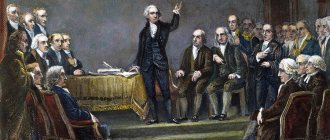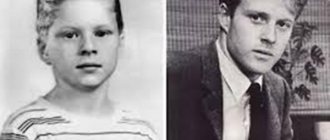Childhood and youth
Jean-Luc Godard was born in Paris on December 3, 1930. The future director was the second of four children. The boy's father, a professional doctor, had previously lived in both France and Switzerland. The mother came from the old Monod dynasty, dating back to the Genevan Protestant theologian Jean Monod. 3 years after the birth of Jean-Luc, the father found a place in a Swiss clinic, and the family left France. Godard received his primary education in Nyon.
Jean-Luc Godard
In his youth, Jean-Luc was fond of sports, especially football, basketball and skiing. Another important moment in the director’s childhood and youth was Protestantism - the family was believers.
Adolescence was difficult: Godard, despite his family's wealth, began to steal. The habit grew into a painful mania, and the boy began to steal even from relatives and friends. When this was revealed, Jean-Luc was 17 years old, and his family did not approve of such a “hobby.”
Jean-Luc Godard in his youth
In 1946, the young man went to Paris, where he continued his education at the Buffon Lyceum. Family connections helped him become a member of the elite circles of the French capital, and Godard lived at that time with the writer Jean Schlumberger. Having failed his bachelor's degree exam in 1948, Jean-Luc returned to Switzerland, where he and his parents settled in Lausanne.
At that time, the elder sister taught the young man to draw, and Godard enthusiastically began painting in an abstract style. A year later, the young man returned to Paris, where he still managed to obtain a bachelor's degree. During this period of his biography, cinematography entered his life. Godard's new friends were young film critics who met in film clubs.
Movies
Godard became part of a generation for whom cinema had a special meaning. According to him, in the 1950s, films were as important as bread, and his peers thought that cinema would become an instrument of knowledge, like a microscope or telescope. At first, Jean-Luc became interested in film criticism. Together with Maurice Scherer, he even founded the magazine “Gazette du cinéma”, which published 5 issues. At that time, Godard did not make films - he was a spectator who wrote about them and helped make them.
Directed by Jean-Luc Godard
In the fall of 1952, Jean-Luc left France and returned to Switzerland, to his mother - his parents’ marriage had broken up by that time. During this period, he became friends with his mother’s lover, who worked at the Clezon-Dixens hydroelectric complex, and thanks to him, he got a job there as a builder. At the same time, Godard decided to make a documentary about the hydro complex. In 1954, the film “Operation Concrete,” shot on a 35 mm film camera, was bought by a management company to then be used for advertising purposes. After this, until 1960, Godard made short films.
In 1960, Jean-Luc released his first full-length film, “Breathless,” starring Jean-Paul Belmondo, which became one of the films of the “New Wave” of cinema. The film combined various elements of the culture that was relevant in those years, in particular the genre features of noir.
Jean-Luc Godard on the set of "Breathless"
From this period, Godard began to include references to the work of his colleagues in his films. In “Breathless,” for example, you can see a poster for the film “The Harder the Fall,” starring Humphrey Bogart. Also in the tape you can find visual quotes from films by Ingmar Bergman, Fritz Lang and other directors.
Another Godard film from 1960, Le Petit Soldier, was initially banned by censors and was not released until 1963. The film, which tells a harsh and truthful story about the war in Algeria, was accused of excessively detailing scenes of violence. However, there are suggestions that the reason for the ban was the unsightly portrayal of France and its role in the Algerian War.
Film by Jean-Luc Godard "The Little Soldier"
The main female role in “The Little Soldier” was played by the aspiring French-German actress Anna Karina. The director used the girl’s inexperience in front of movie cameras to make the film even more realistic. Working together led to the fact that by the time filming ended, an affair began between Jean-Luc and Anna.
In 1963, Godard made his most commercially successful film, Contempt, in which the leading role was played by the main star of French cinema, Brigitte Bardot. The film was recognized as the pinnacle of modernism in cinematography. The next year for Jean-Luc was marked by the release of the film “The Outsiders” (aka “Band of Outsiders”), which Godard himself described in an interview as follows:
"Alice in Wonderland meets Franz Kafka."
Jean-Luc Godard's film "Contempt"
After this, in 1965, the director made "Alphaville" - a fantastic noir dystopia that raises questions of totalitarian power and highlights the negative sides of technocracy.
In the wake of social changes in the world community, Jean-Luc Godard began to touch on political themes in his works. In 1967, he directed the film “The Chinese Woman,” which, while not being the director’s most famous film, is considered one of the best in his filmography. The film is a free adaptation of Fyodor Mikhailovich Dostoevsky’s novel “Demons” and attempts to artistically rethink the teachings of Mao Zedong.
Film by Jean-Luc Godard "The Chinese Woman"
By the 1980s, having abandoned political and social themes, Jean-Luc returned to neutral cinema and creativity for the sake of art. During this period, films such as “Save Who Can (Your Life)”, “Passion” and another experimental film adaptation of Shakespeare’s “King Lear” were shot.
Over the course of 10 years, from 1988 to 1998, Godard produced what is perhaps his most voluminous and monumental work: the documentary series “History of Cinema: Only History.”
Film by Jean-Luc Godard "Our Music"
In 2004, the social theme returned to the director’s art - Jean-Luc made the film “Our Music,” dedicated to the Arab-Israeli conflict and the topic of modern wars in general. The stylistic feature of the painting is that it consists of 3 parts, named, as in the Divine Comedy, “Hell”, “Purgatory” and “Paradise”. Moreover, “Paradise” looks like a coastline that is tirelessly patrolled by US Marines.
The 2010s in Godard’s work are a period of experimentation. Thanks to the 3D film “Farewell to Speech,” the director was awarded the jury prize at the Cannes Film Festival. 3 years before this, Jean-Luc's services to the world film industry were for his contribution to the development of cinema.
The most interesting
Actresses who received the Golden Raspberry for Worst Actress (02/13/2020)
Famous actresses who should not show their legs (02/13/2020)
After this film, Jean-Luc began to be called a pioneer of the “new wave”. This movement arose in the fifties, and its founders were directors who did not want to make commercial films based on ready-made standards.
By the end of the sixties, the “new wave” ceased to interest Godard, and Marxism became his new hobby. Another Godard film, which became one of the striking examples of the “new wave,” “A Woman is a Woman,” was filmed in 1961, and the main role in it was played by Jean-Luc Godard’s wife, Anna Karina.
In the photo: a working moment during the filming of the film “A Woman is a Woman”
During the social crisis in France, which resulted in student demonstrations and riots, Jean-Luc Godard began making propaganda films and became one of the ideological inspirers of the leftist movement. Together with Jean-Pierre Gorin, Godard created a group engaged in filming political films, and they called it “Dziga Vertov”. The group existed until 1972.
“It was an individual rebellion, and much belatedly I realized that I must associate myself more closely with the great social movements,” wrote Jean-Luc Godard.
The return to big cinema in 1980 was marked by the release of the films “Save Who Can (Your Life)”, “Name: Carmen”, “Passion”. In 2010, Godard directed the film Socialism, the plot of which takes place on a cruise ship.
The director was not going to stop, and in 2014 he shot the experimental film “Farewell to Speech” 3D. The film took a very long time to film, and then it took at least as long to edit and process it. The film was awarded a prize at the Cannes Film Festival and several other awards.
Photo: Godard filming Adieu to Speech
"Farewell to Speech" was recognized as one of the best films of 2014.
Personal life
The director's personal life has repeatedly come under close attention from the press and public. Godard's first wife was Anna Karina, whose creative union led to the creation of Jean-Luc's most popular films. In the 1960s, Karina and Godard were considered one of the most famous couples in cinema; photos of the spouses regularly appeared in the press. After the divorce, the couple stopped communicating.
Jean-Luc Godard and Anna Karina
In 1967, on the set of The Chinese Woman, Jean-Luc met Anne Wiazemsky, an actress who was the granddaughter of François Mauriac, a famous French writer. The marriage lasted until 1979 and also ended in divorce. The director has no children.
Jean-Luc Godard and Anna Wiazemsky
In the early 80s, Godard met Anne-Marie Miéville, who actually became his third wife, albeit without an official marriage ceremony. Like other women who left their mark on Jean-Luc's life, Anne-Marie is involved in cinema - she is a director and has repeatedly helped Godard in his work.
Godard’s political and personal views also repeatedly aroused the interest of journalists, the public and colleagues. Since the 1970s, Jean-Luc has taken a pro-Palestinian position, which is reflected in the films Our Music and Here and There.
Jean-Luc Godard and Anne-Marie Miéville
In May 2020, the director joined the boycott of Israeli cinema. Godard denies the Holocaust, and in 1978 admitted that his family openly sympathized with the Nazis. Jean-Luc said about his grandfather that he was an anti-Semite, and expressed his opinion about the state of Israel by naming the country
"the cancer of the Middle East."
Godard's support for disgraced director Roman Polanski, who was arrested in 2009 on charges of raping 13-year-old Samantha Geimer, was also considered dubious.
Online magazine Cineticle
Alain Bergala. How did you become a critic?
Jean-Luc Godard. I knew Valcroze, the son of my mother’s friend, and first tried to offer my opuses to the Revue du Cinema magazine, where Jacques Doniol-Valcroze, Lo Dukas and André Bazin collaborated. But I was refused. Then I contacted “Objectif-49? and in a sheet called “Cinema Club of the Latin Quarter,” but Rivette was enough for them. I think I published my first article in the Gazette du Cinema entitled “In Defense of Political Cinema” (note: Godard is mistaken. His first article in the Gazette was about Joseph Mankiewicz’s film “House for Strangers”). It was about Soviet cinema. I showed it to Bazin, who was then ill. He began publishing in “Ar” and “Kaya”. I wrote the first article in “Kaya” about Rudolf Mate’s painting “The Fading Flame” with Margaret Sullivan in the title role.
Alain Bergala. Why did you first publish under the pseudonym Hans Luca?
Jean-Luc Godard. Don't know. Probably so as not to sign Jean-Luc. In German Hans Luca will be Jean-Luc. Apparently, I was cautious, and for purely literary reasons: at that time I really wanted to publish the novel at the Gallimard publishing house. And I took a pseudonym following the example of Astruc.
Alain Bergala. How did you get into “Cahiers”?
Jean-Luc Godard. At the instigation of Truffaut and the “Cinema Club of the Latin Quarter”, where the “Scherer Gang” reigned (approx. - this was the name of the group of young critics - future eminent directors of the New Wave - who wrote in the "Gazette du Cinema" and "Cahiers du Cinema". Its leader was considered Eric Rohmer, whose real name is Jean-Marie Maurice Scherer). I didn’t know Rohmer at that time, but it was he who published a fundamental article about Murnau in the Revue du Cinema, in which he assessed modern cinema. It was called “Cinema as Spatial Art.” At that time, Rohmer professed rather right-wing views, which irritated Bazin a little with his ultra-left beliefs. Rivette personified a kind of cinematic extremism. I always wrote after others. And I started making films after Rohmer and Rivette. Rohmer, in collaboration with Jegoff (approx. - Paul Jegoff, 1922 - 1983, - screenwriter, dialogueist, director) made many narrow-film films. I remember the “Kreutzer Sonata”, a silent picture, because then it was impossible to write sound on a narrow film. Rohmer and Rivette were my influences. Rivette was strong in theory, and Rohmer was strong in film analysis.
Alain Bergala. There is a sense of partisanship in your articles in relation to Bazin’s orthodoxy. You did not at all share his cult of the “plan-episode”; you admired the editing.
Jean-Luc Godard. There has always been a spirit of contradiction within me. Bazin preached the episode, and I asked myself: why is the classic storyboard worse? We showed each other articles. The opinions of others mattered a lot. Approval was tantamount to a “recruitment” resolution. Like the church fathers who show each other their texts. I remember I wrote an article about the second cut of Hitchcock's The Man Who Knew Too Much. Scherer was furious. In his opinion, the film was a failure, it was made with his left foot... And he killed the article. Bazin was a director who did not make films. He was involved in cinematography, talking about it like a traveling salesman about his product. If I liked a movie and Rivette thought it was crap, I said the same thing. There was something of Stalinism in our relationship. Rivette arrogated to himself the right to declare the ultimate truth, and I supported him for some time. I behaved more independently towards others. Like Truffaut, I had a predilection for average French films.
Alain Bergala. In your articles you often write about the plot. Let's say in such and such a film he is modern and good, but in such and such a film he is not. It’s interesting that after filming “Breathless” you said that the film had no plot. What do you think today?
Jean-Luc Godard. I really think that my first films have no plot. Compared to other forms of art, I was always surprised in cinema by the fact that you can start work from scratch. I don’t understand why people write scripts when no one reads them, except for the actors, who do it to calculate how many lines to say and to know what to do in the frame. In cinema, you can start shooting a picture literally from scratch.
Alain Bergala. Your reviews in “Kaya” feel your own style. On the one hand, you pay tribute to the rhetoric characteristic of the magazine, on the other, you write “bare” criticism.
Jean-Luc Godard. At that time, the “beautiful style” in “Kaya”, dating back to the 18th century, was highly valued. I started by reading modern literature, with Selina, and only then turned to the classics. I perceived my collaboration with Cahiers as a literary activity.
Alain Bergala. Was it easy or difficult for you to write?
Jean-Luc Godard. It's always difficult. And at the last moment. But at this last moment I experienced orgasmic pleasure.
Alain Bergala. Do you feel the same way when making films?
Jean-Luc Godard. I haven't changed. I'm still waiting until the last minute. Even when I'm trying to write snatches of phrases for scripts. This is where the joy lies, which is experienced in creativity and, probably, during childbirth. First you feel pain, followed by the pleasure inherent in every act of creation, when something is born out of nothing.
Alain Bergala. Maybe you start writing the script at the last minute so that there is no time for rewrites and revisions?
Jean-Luc Godard. Absolutely right. Besides, I am convinced that if there is enough material, installation will fix everything.
Alain Bergala. So what do you do then?
Jean-Luc Godard. I cut mercilessly, risking depriving the film of its credibility. But if there is a strong plot, persuasiveness is not a problem.
Alain Bergala. Why did you pay so much attention to Nicholas Ray when you were a critic?
Jean-Luc Godard. I loved many of the directors, hearing what others had to say about them in “Kaya.” But I didn’t look into it too much. True understanding came later. Let's say, it took me a long time to understand and appreciate Hitchcock. One of his most non-commercial films, “I Confess,” helped me with this. And it seemed to me that such a combination of quasi-documentary and religious content was accessible, besides Hitchcock, only to Nicholas Ray.
Alain Bergala. What prevented you from immediately appreciating Hitchcock?
Jean-Luc Godard. What others said about him, especially Chabrol and Rohmer, who relied most on the literary side. Even Truffaut talks more about themes and scenarios when talking to him. I myself discovered quite late that he was a creator of form, an artist-painter, that he should be spoken of as Tintoretto, without being limited by the framework of the script, suspense or religiosity. I realized this after watching seven or eight of his best films one after another.
Alain Bergala. Bazin then especially rebelled against Hitchcock, because he believed that his films had no plot.
Jean-Luc Godard. We followed Rivette in writing about the role of directing, although this expression came from the theater. Bazin had in mind the classical idea of the plot, and he and I had no reason to argue.
Alain Bergala. Perhaps the plots of Nicholas Ray's films were closer to you than Hitchcock's... Have you often visited the Cahiers editorial office?
Jean-Luc Godard. This was our home, I visited there more often than others. We'd get ready at Kaya after two o'clock, then go to the cinema and return there in the evening. For a long time I have been sending out a magazine to subscribers. Lidie Maillet and Valcroze willingly did this. Sometimes Romer helped us too. I did this every month.
Alain Bergala. In some articles you prefer Bergman to Visconti.
Jean-Luc Godard. I still have this preference. Although today I understand Visconti better - especially his last films - unlike Bergman, by the way. However, I prefer Bergman's cinematic feel to Visconti's.
Alain Bergala. At that time, you invariably singled out the works of John Ford among the best films. What attracted you to Ford?
Jean-Luc Godard. Ford professed the idea that cinema is just cinema, that everything in it should be simple. This man invariably turned to the same subjects. This is usually characteristic of writers, especially European ones. And I was also attracted by the documentary nature of his films - a horse, a singing man, a girl, a landscape and... everything. This is what he did all his life. He can be called an absolute director.
Alain Bergala. After the film “Breathless,” did you continue to visit “Kaya”?
Jean-Luc Godard. Yes, for a long time. This was my real home. Anna (note - this means Anna Karina, at that time Godard’s wife and an actress in his films) was unhappy with the fact that I went to Cahier, the way others go to a cafe or a billiard room. But I did not give in to her, I wanted to be, so to speak, “at the crest of events.”
Alain Bergala. Did others do the same?
Jean-Luc Godard. It seems this continued until 1968.
Translation from French and notes by A. Braginsky
Published in the magazine “The Art of Cinema”, 1998, No. 1
Jean-Luc Godard.strongp style=p style=
Tags:
- issue 1
- Jean Luc Godard
Jean-Luc Godard now
Now the director continues his creative work, despite his age - in 2020, Godard turned 88 years old. Moreover, soon after this, Jean-Luc was almost “buried” - false information about the director’s death appeared on the Internet.
Jean-Luc Godard in 2018
It later turned out that the Twitter account, successfully stylized as the official page of the Swiss Ministry of Culture, belonged to the scandalous Italian Tommaso Debenedetti, who had previously repeatedly published fake statements on behalf of popular people.
Literature
in Russian
- Vinogradov V.
Anti-cinema J.-L. Godard, or Dead Men on Holiday. — Kanon + ROOI “Rehabilitation”, 2012. — 280 p. — 800 copies. — ISBN 978-5-88373-323-8. - Medvedev K., Adibekov K.
Fight on two fronts. Jean Luc Godard and the Dziga Vertov group. - M.: Free Marxist Publishing House, 2010. - 111 p. - Goodbye speech? The philosophy of Godard’s film and the modern concept of man (Articles by Andrey Bychkov, Fyodor Girenok, Vladimir Martynov, Natalia Rostova, Vadim Rudnev). - M.: Summer Garden, 2015. - 120 p. — ISBN 978-5-98856-230-6. — (Series “Modern Russian Philosophy”).
- Wim Wenders.
Image logic. - B&K, 2003. - 432 p. — ISBN 5-93414-100-7. - Jean-Luc Godard.
Passion. Between black and white / comp. M. B. Yampolsky. - 1997. - 156 p. - Tarasov A. N. “Godard as Voltaire” // Tarasov A. N. Country X. - M.: AST; Adaptek, 2006. (with minor abbreviations published in the magazine "House of Unions", 1993, No. 2)
- Trofimenkov M. S. Two or three things that I know about him. To the 60th anniversary of Jean-Luc Godard. // The art of cinema. - 1991. - No. 2.
- Trofimenkov M. S. Godard about Godard: compilation, comments, translation // The Art of Cinema. - 1991. - No. 2.
- Godard, Jean-Luc / Trofimenkov M. S. // Hermaphrodite - Grigoriev [Electronic resource]. - 2007. - P. 292. - (Big Russian Encyclopedia: [in 35 volumes] / chief editor Yu. S. Osipov; 2004-2017, vol. 7). — ISBN 978-5-85270-337-8.
- Trofimenkov M. S.
Godard, Jean-Luc // Great Russian Encyclopedia: electronic version. — 2020. — June 1. — Date of access: 08.11.2018.
in other languages
- Douglas Morrey.
Jean-Luc Godard. - Manchester: Manchester University Press (English) Russian, 2005. - 271 p. — ISBN 978-0719067594. - Jean Collet.
Jean-Luc Godard: An Investigation Into His Films and Philosophy. — New York: Crown Publishers, 1970. - Roberto Chiesi.
Jean-Luc Godard. - Gremese, 2005. - P. 128. - ISBN 978-8873015840. - Richard Brody.
Everything Is Cinema: The Working Life of Jean-Luc Godard. - Macmillan, 2008. - 720 p. — ISBN 978-0-8050-6886-3.
Filmography
- 1954 — “Operation Concrete”
- 1960 — “Breathless”
- 1960 — “The Little Soldier”
- 1963 — “Carabinieri”
- 1963 — “Contempt”
- 1964 — “The Outsiders”
- 1965 — “Alphaville”
- 1966 - “Made in the USA”
- 1967 — “Chinese Woman”
- 1972 — “Letter to Jane”
- 1980 - “Save whoever can (your life)”
- 1982 — “Passion”
- 1987 — “King Lear”
- 1987 - “Aria” (fragment “Armida”)
- 1996 - “Mozart - Forever”
- 2004 — “Our Music”
- 2010 — “Socialism”
- 2014 — “Farewell speech 3D”
- 2018 — “Book of Image”, or “Image and Speech”











